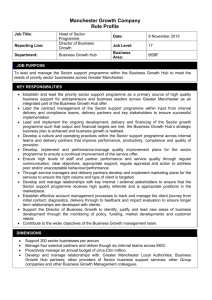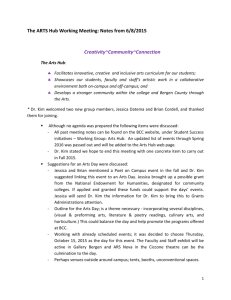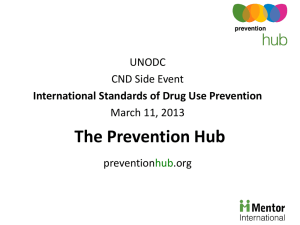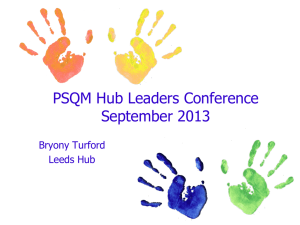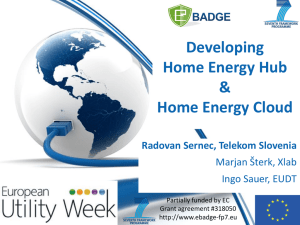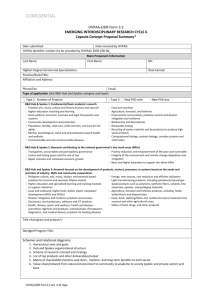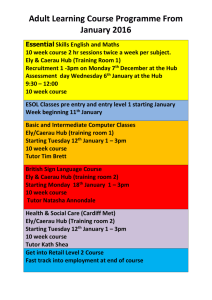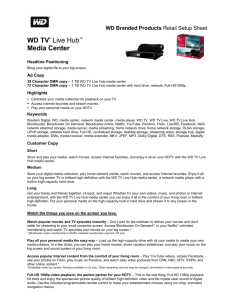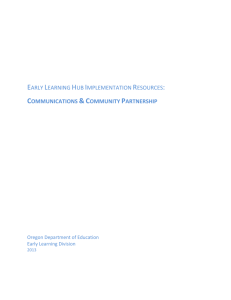Hub Science Communication Plan Template
advertisement
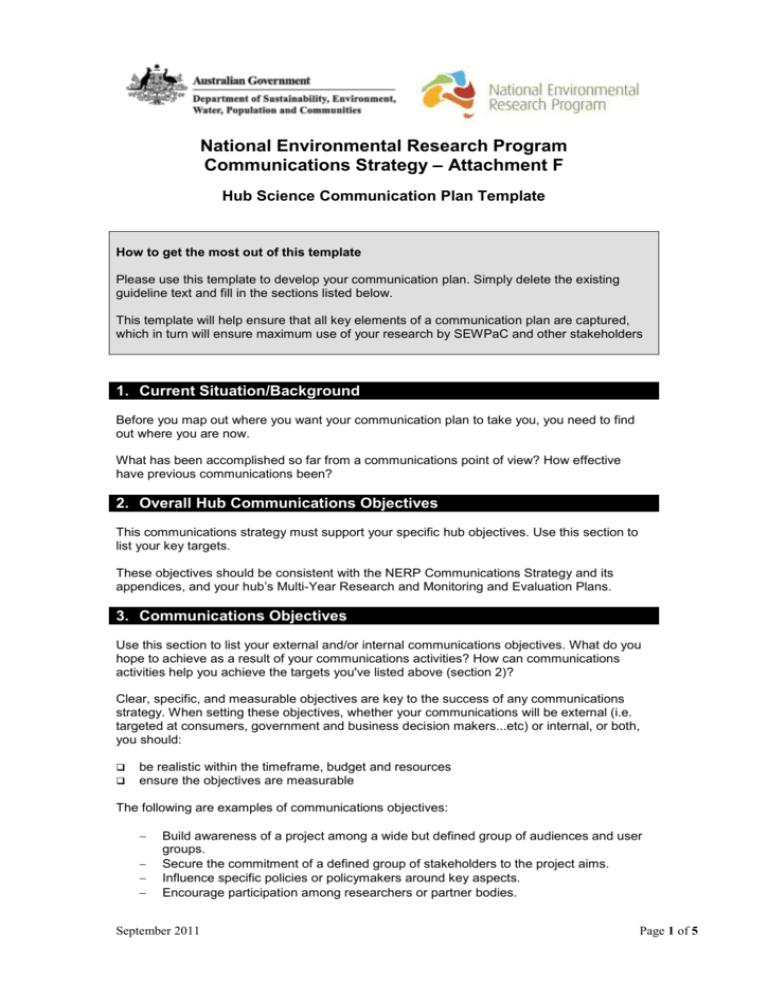
National Environmental Research Program Communications Strategy – Attachment F Hub Science Communication Plan Template How to get the most out of this template Please use this template to develop your communication plan. Simply delete the existing guideline text and fill in the sections listed below. This template will help ensure that all key elements of a communication plan are captured, which in turn will ensure maximum use of your research by SEWPaC and other stakeholders 1. Current Situation/Background Before you map out where you want your communication plan to take you, you need to find out where you are now. What has been accomplished so far from a communications point of view? How effective have previous communications been? 2. Overall Hub Communications Objectives This communications strategy must support your specific hub objectives. Use this section to list your key targets. These objectives should be consistent with the NERP Communications Strategy and its appendices, and your hub’s Multi-Year Research and Monitoring and Evaluation Plans. 3. Communications Objectives Use this section to list your external and/or internal communications objectives. What do you hope to achieve as a result of your communications activities? How can communications activities help you achieve the targets you've listed above (section 2)? Clear, specific, and measurable objectives are key to the success of any communications strategy. When setting these objectives, whether your communications will be external (i.e. targeted at consumers, government and business decision makers...etc) or internal, or both, you should: be realistic within the timeframe, budget and resources ensure the objectives are measurable The following are examples of communications objectives: Build awareness of a project among a wide but defined group of audiences and user groups. Secure the commitment of a defined group of stakeholders to the project aims. Influence specific policies or policymakers around key aspects. Encourage participation among researchers or partner bodies. September 2011 Page 1 of 5 These objectives should be consistent with the NERP Communications Strategy and its appendices, and your hub’s Multi-Year Research and Monitoring and Evaluation Plans. 4. Target Audience If you're targeting an external audience - who do you want to get your message across to? Be as specific as possible: Target audiences should be described in terms of: current behaviour level of awareness level of knowledge preferred methods for receiving information motivations/barriers to hearing and believing/accepting the information. The more refined the target audience description, the more precise and effective your communication will be. Broad descriptions such as the “general public” are less likely to lead to a successful communications campaign than a tightly defined target. The more thoroughly you understand your target audience(s), the higher the probability of communications success. The key target audiences are likely to include: The Minister for Sustainability, Environment, Water, Population and Communities The Environment Portfolio including statutory authorities such as the Great Barrier Reef Marine Park Authority and Bureau of Meteorology Other Australian Government agencies (e.g. Dept of Climate Change and Energy Efficiency; Dept of Agriculture, Fisheries & Forestry, Rural R&D Corps, Dept of Industry, Innovation, Science and Research) State and Local Government Agencies, NRM Regional Bodies NERP Hubs and Researchers Other environmental researchers and Scientific Organisations (e.g. CSIRO, CRCs, other university researchers) Indigenous communities Industry Non-government organisations General public 5. Key Message per Target Audience Fill out the following for each target audience you want to communicate to. What is it that you want to change? What do you want the target audience to know? What mechanism exists for your hub to respond to the needs and challenges posed by end users? September 2011 Page 2 of 5 What do you want them to feel - what perception do you want to create? What do you want them to do - what action do you want as a result? Examples of a "result" could include the following: Do you want to change their attitude towards your area of research? Do you want to change the awareness of the environmental hazards in a particular region? Do you want them to be motivated to take action or make a decision? 6. Communications Mix and Timeline How do you want to get the message across? This plan will cover the life of your hub, and be amended as required during this time. What tools will you need to use during this timeframe? Your choice will depend on what you want to achieve, the level and type of message you want to communicate, and the profile of your audience. The hub leaders (and Tropical Ecosystem Hub Science Leader) and researchers will be responsible for the majority of communications activities, particularly the dissemination of research products. Hubs are expected to maintain dedicated communications and/or knowledge broking staff, who will have a role in facilitating this, particularly towards the environment portfolio (including a presence in Canberra and other government centres). Government Communications Mix Synthesis products and tools targeted at particular line areas within government Targeted workshops and events (including training and occasional lectures) Conferences Web tools Research leader briefings to senior executives on challenges facing the portfolio Potential researcher placements within SEWPaC (subject to negotiation and approval) Annual reporting to SEWPaC and milestone reports Updated multi-year research plan, annual work plan, communication plan and monitoring and evaluation plan External Communications Mix Print Synthesis Reports Brochures Posters Journal articles Letters Publication Scientific reports Etc Press Press release Radio Opinion editorial Features Features advisories September 2011 Page 3 of 5 Online Hub website and web tools etc. e-mail newsletter TV News and features Long-format programs and online television options Advertising Print Public Relations Events Telephone calls conferences Etc Internal Communications Mix Conference calls Face-to-face meetings Etc When will you need to communicate over the next 12, 24 or 36 months? List the key dates - what do you need and when. This timeline should be consistent with your Hub’s Multi-Year Research Plan and Annual Research Plans. Describe each key event or activity that will need communications (incl. launch of a report, forum, conference, etc.). What, Why, Where, When, Who, How, Target, Audience, Objective, Key Message(s), Media Strategy, Tools and Materials. Under this section you can also attempt to identify, or at least anticipate, any communications opportunities that may emerge from the actions of others working in the region, e.g., events such as partner or other agency media events, legislation processes, or expected government announcements. Describe those opportunities here. Activity Objectives/Actions Timeline 7. Promotion Once you've decided what your communications mix will be, you need to determine how you will promote the various components. In other words, how will you promote your "product". September 2011 Page 4 of 5 For example, if you need to develop a website in order to meet your communications objectives, how do you intend on promoting the site throughout key stakeholders? What is your plan to drive external traffic to the site? How will you effectively engage key end users within the environment portfolio and elsewhere? Note that the Scientific Research and Information Section of SEWPaC will aid in this process. 8. Budget Where possible, list the following: The amount of money available now The sources of funding (including potential future sources The amount of money available in the future Other leverage options, including collaborations 9. Evaluating Success How will you know if you have succeeded and met your objectives? How are you going to evaluate your success, what performance indicators and evaluating measures will you use? It's important to assess your strategy/project so that any changes, if necessary, can be made when engaging in a similar strategy/project in the future. This section should be consistent with your multi-year research plan and monitoring and evaluation plan. Have you achieved your objectives)? Did you reach the right audience? Did you use the right tools? Were decisions taken as a result? Did you come in on budget? If you didn't, why not? Etc September 2011 Page 5 of 5
